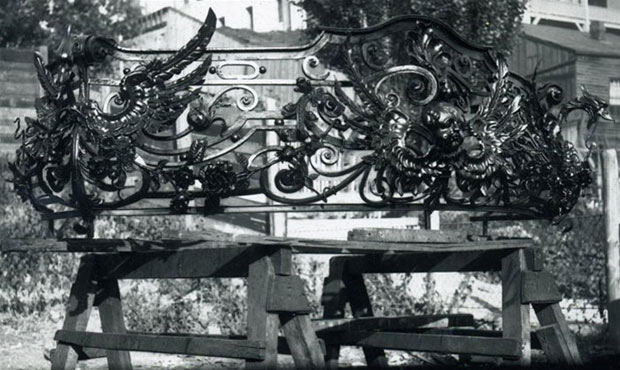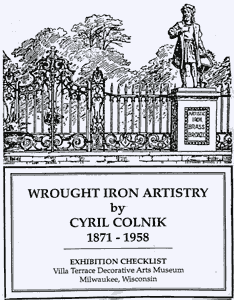WROUGHT IRON ARTISTRY BY CYRIL COLNIK, 1871-1958
The Cyril Colnik Collection at Villa Terrace Decorative Arts Museum THE ARTISTRY OF CYRIL COLNIK
Tools used for centuries at the forge were the instruments for artistry with metal in the hands of Cyril Colnik. His creative talent and technical mastery transformed metal into works of beauty and permanence. Colnik became nationally known and archived his success in his adopted country and home, Milwaukee, Wisconsin. Colnik, son of Dominick and Anna Rudmilla Colnik, was born September 20, 1871, on the family estate in Triebein, Austria. His father, a prominent veterinarian, economist and politician, had a blacks's shop on the estate, and at a very early age Colnik was exposed to the working of the forge. During the late 1880's, Colnik apprenticed as a mechanical assistant. He studied iron work in Vienna before moving to study with ironworker Franz Roth in Graz. Colnik also studied in Italy, France, Switzerland, Spain and Germany. He later enrolled the Munich Industrial Art School; the faculty recognized Colnik's ability, and recommended that he assist in setting up the German government's exhibition and show at the World Columbian Exposition, Chicago in 1893. Following the exposition, Colnik moved to Milwaukee and opened his own ironwork shop, where he worked until his retirement in 1955. It has been suggested that Captain Frederick Pabst may have influenced Colnik to settle in Milwaukee. The Pabst Pavilion was brought to its intended site as part of the Captain's new home at 2000 WEst Wisconsin Avenue after the Exhibition closed. During 1894-1905 Colnik did extensive wrought iron work on the Pabst mansion; meanwhile, his reputation in Milwaukee grew and clients increased. Many successful professional people, industrialists and merchants were emerging during this period and they sought new residences suitable to their status in the community; people required excellence in workmanship and the means to pay for it. The Herman Uihlein home at 5270 North Lake Drive for example, required three years of Colnik's time to complete the work he designed for the mansion. Colnik's business grew and eventually employed up to 25 people. His 1914 advertisement read: Colnik's work included out-of-state commissions for the Insul and Ryerson homes in Chicago, and the Ringling mansion in Sarasota, FL. The only piece of work which Colnik signed is an escutcheon done in repousee, a technique widely used in Europe requiring great skill. It is executed on a bed of pitch with tallow added to allow flexibility, and pounded out from the back and front to form the design in bas-relief. The piece is signed in the lower right-hand corner. The shield is plain convex oval, flanked in the upper half by human figures and centered at the top with a crown and leaves. Colnik's premier work in wrought iron , Master Piece (1891-1893) features a fantastic winged and horned human figure, impishly peering out from a mythical landscape of tendrils and flowers. Among the many objects in his oeuvre are a variety of candlesticks, a dancing dragon; chai9rs, tables, ashtrays, lamps, grills, andirons, display panels with mounted samples of cast and stamped decorative fragments. Although noted for his use of blooming roses, small rose buds, and brambles with bark, Colnik's motifs also included other flowers, flames and vines. The artistry of Cyril Colnik was synonymous with the growing affluence of Milwaukee in the late 19th century. |

